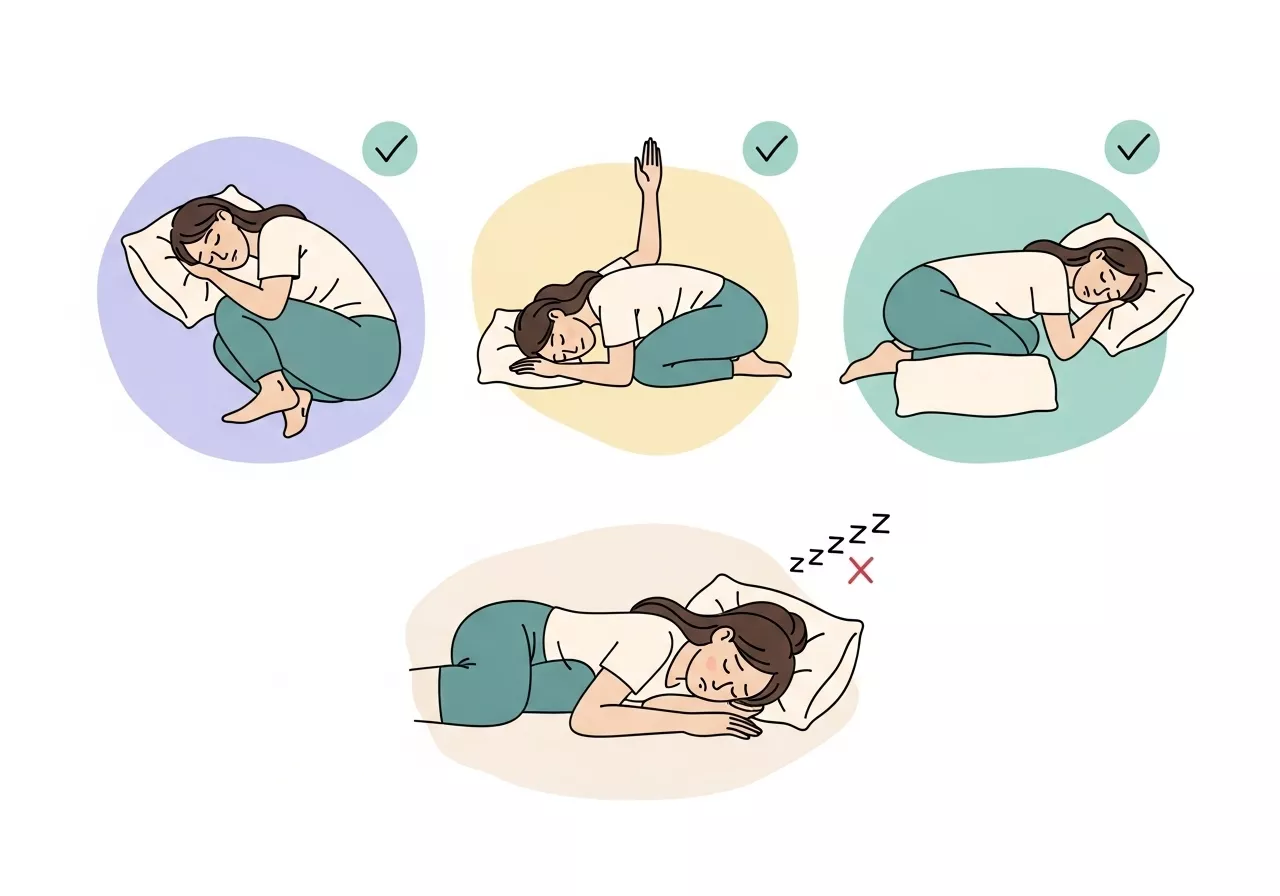Practicing yoga with a partner can transform your routine into an engaging, interactive experience.
Partner yoga promotes deeper stretches, improved balance, and mutual trust while fostering a stronger connection with your yoga partner.
Whether you’re an experienced yogi or just starting, these two-person yoga poses offer a mix of fun and challenge for any level.
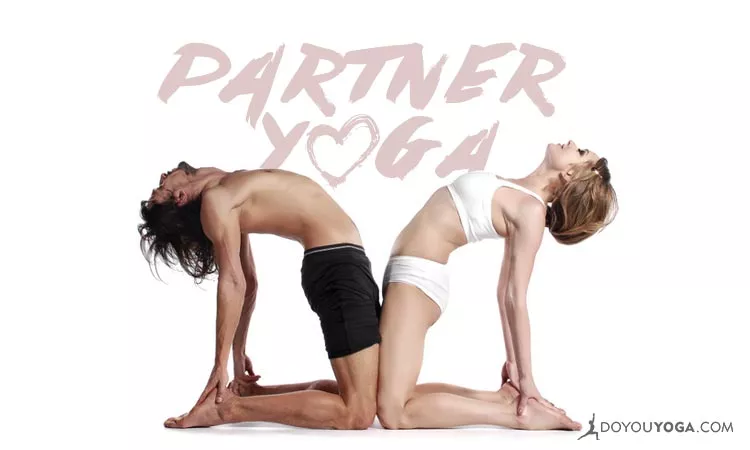
Below, we’ll explore beginner and intermediate poses, along with tips to help you safely and effectively incorporate them into your practice.
Beginner-Friendly Two-Person Yoga Poses
For those new to partner yoga, these poses are an excellent way to ease into the practice while building confidence and trust with your partner:
1. Partner Forward Fold
- How to Perform:
Sit facing each other with your legs extended in a wide straddle position. Hold each other’s hands and alternate gently leaning forward, allowing one partner to stretch their back and hamstrings while the other offers support.
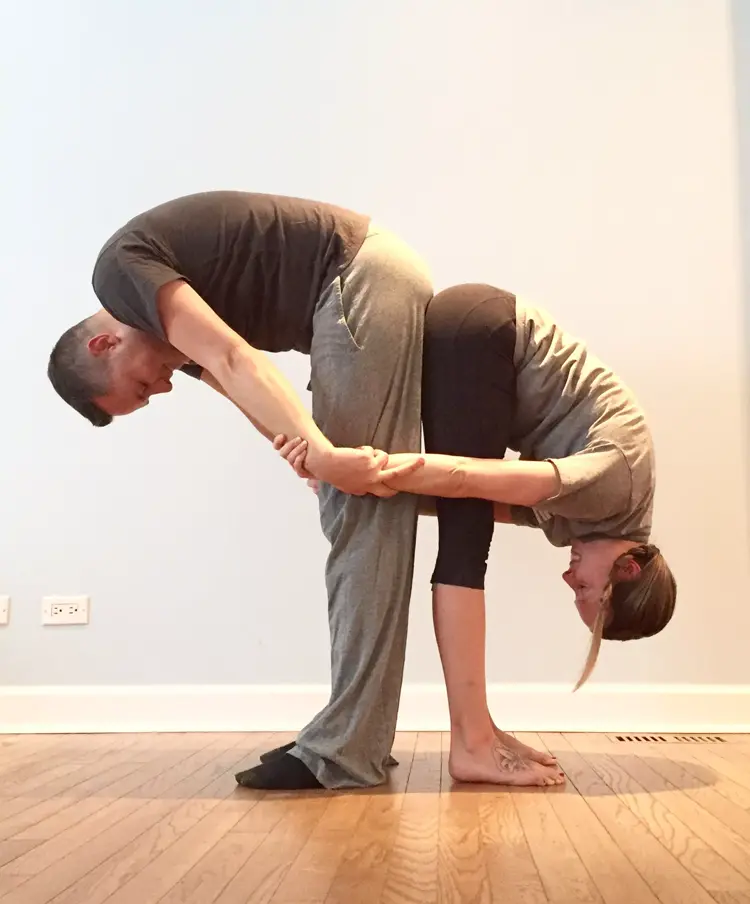
- Benefits:
Enhances flexibility in the hamstrings and lower back, while promoting trust and synchronized breathing.
2. Seated Spinal Twist
- How to Perform:
Sit back-to-back in a cross-legged position. Each person places their right hand on their partner’s left knee and their left hand on their own right knee. Twist gently to the side, ensuring a steady flow of breath.
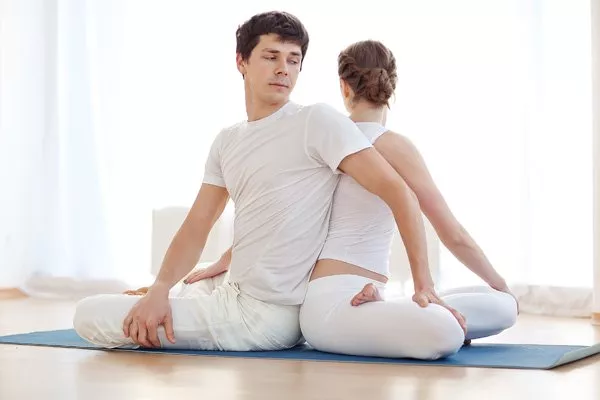
- Benefits:
Relieves tension in the back, improves spinal mobility, and encourages mindfulness.
3. Double Tree Pose
- How to Perform:
Stand side-by-side with your inner arms around each other’s waists for stability. Each person lifts their outer leg and places the sole of their foot against the inner thigh or calf of their standing leg. Raise your outer arms together to form a tree branch overhead.
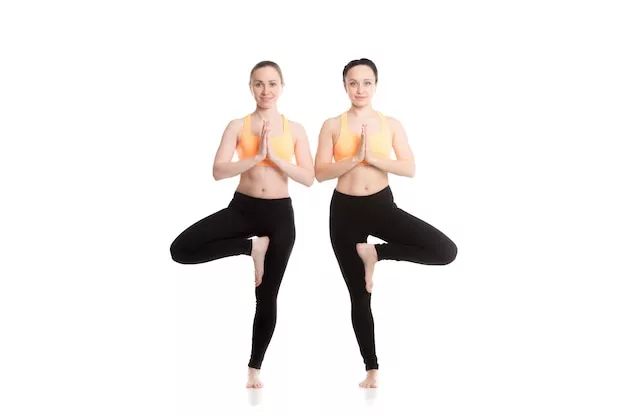
- Benefits:
Improves balance, core strength, and focus while creating a feeling of unity.
4. Temple Pose
- How to Perform:
Face each other with feet about hip-width apart. Raise your arms overhead, hinge forward at the hips, and press your palms and forearms together. Adjust the intensity of the stretch by leaning forward or back.

- Benefits:
Opens the chest and shoulders, improves posture, and strengthens the lower body.
5. Partner Boat Pose
- How to Perform:
Sit facing your partner with your knees bent and toes touching. Hold hands, lift your feet, and press the soles together. Straighten your legs to form a “W” shape with your bodies. - Benefits:
Strengthens the core, enhances coordination, and improves balance.
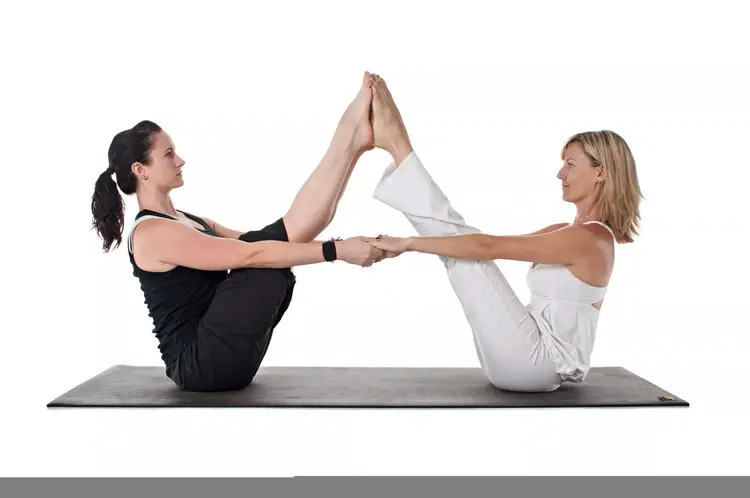
Intermediate Partner Yoga Poses
Once you’ve mastered the basics, these poses offer a bit more complexity and challenge to deepen your practice:
1. Supported Backbend Pose
- How to Perform:
Stand facing each other and hold each other’s forearms for support. Lean back slowly, allowing your upper bodies to arch backward. Ensure you maintain a firm grip for stability. - Benefits:
Stretches the chest, shoulders, and back while promoting trust and coordination.
2. Partner Downward Facing Dog
- How to Perform:
One partner assumes a standard downward dog pose with hands and feet firmly planted on the ground. The other partner positions their hands on the base’s back and carefully lifts their feet onto the base’s lower back, forming a stacked pose. - Benefits:
Deepens the downward dog stretch, improves balance, and strengthens the core and upper body.
3. Double Dancer Pose
- How to Perform:
Face your partner, holding each other’s opposite hands. Each person lifts one leg back and holds the foot or ankle with the free hand, finding balance together in the dancer pose. - Benefits:
Builds balance, flexibility, and focus while enhancing the aesthetics of the pose.
4. Double Plank Pose
- How to Perform:
One partner holds a standard plank position on the ground. The second partner carefully places their hands on the base’s ankles and their feet on the base’s shoulders, forming a stacked plank. - Benefits:
Strengthens the core, shoulders, and arms while requiring precise coordination.
5. Downward Dog Bow Pose
- How to Perform:
One partner assumes a downward dog position. The second partner sits facing the base’s head, places their feet on either side of the spine, and leans back into a bow pose. - Benefits:
Combines a backbend and shoulder stretch with the traditional downward dog, enhancing flexibility and alignment.
Tips for Practicing Partner Yoga Safely (Detailed Guide)
Engaging in partner yoga requires focus, clear communication, and a deep sense of mutual respect to ensure a safe and enjoyable experience.

Follow these detailed tips to maximize the benefits while minimizing the risks:
1. Communicate Openly and Clearly
- Why It Matters: Effective communication is the foundation of partner yoga. Discussing your intentions and limitations helps establish a sense of trust and understanding.
- How to Apply:
- Before starting, talk about your experience levels and physical capabilities.
- Use clear verbal cues during poses to indicate adjustments or discomfort. For instance, say “a little more pressure” or “ease off” to guide your partner.
- Check in with your partner regularly to ensure the pose feels safe and comfortable for both of you.
2. Prioritize Warm-Up and Stretching
- Why It Matters: Warming up helps loosen muscles, improves flexibility, and prepares your body for the demands of partner poses.
- How to Apply:
- Spend 5–10 minutes on individual warm-up poses, such as cat-cow stretches, seated forward folds, or gentle twists.
- Practice simple synchronized breathing exercises with your partner to promote relaxation and focus.
- Gradually ease into partner poses to avoid sudden strain on the body.
3. Listen to Your Body and Your Partner’s Cues
- Why It Matters: Everyone’s body has limits, and pushing beyond them can lead to discomfort or injury.
- How to Apply:
- Be mindful of your own body’s signals, such as pain or tension, and communicate these to your partner immediately.
- Pay attention to non-verbal cues from your partner, like wincing or hesitation, and respond accordingly.
- Avoid comparing yourself to others; focus on your own pace and abilities.
4. Use Props for Support
- Why It Matters: Yoga props can make poses more accessible and help both partners maintain proper alignment.
- How to Apply:
- Place yoga blocks under hands or feet to improve stability during standing or balancing poses.
- Use a strap to assist in reaching or holding poses, particularly if one partner has limited flexibility.
- Cushions or bolsters can provide extra support for seated poses or help reduce strain on joints.
5. Focus on Alignment and Balance
- Why It Matters: Proper alignment prevents strain and ensures that both partners can perform poses safely and effectively.
- How to Apply:
- Pay close attention to posture during each pose. For example, keep the spine straight and shoulders relaxed during seated poses.
- Align your body symmetrically with your partner to distribute weight evenly, especially in balancing poses.
- Use a mirror or ask a third person to observe and offer guidance for maintaining alignment.
6. Start Slow and Build Gradually
- Why It Matters: Jumping into advanced poses without proper preparation can lead to frustration or injury.
- How to Apply:
- Begin with beginner-friendly poses like the Partner Forward Fold or Temple Pose to build confidence.
- Progress to intermediate poses once you feel comfortable and stable with basic ones.
- Take breaks if needed, and don’t rush to complete a sequence in one session.
7. Create a Comfortable Environment
- Why It Matters: The right setting enhances focus and reduces external distractions, making the practice more enjoyable.
- How to Apply:
- Choose a quiet, spacious area with sufficient room for movement.
- Use a non-slip yoga mat to ensure stability during poses.
- Adjust the lighting and play calming music to create a relaxing ambiance.
8. Practice Patience and Trust
- Why It Matters: Partner yoga is as much about mental connection as it is about physical movement. Developing patience and trust ensures a harmonious experience.
- How to Apply:
- Approach the practice with an open mind and avoid blaming each other for mistakes or missteps.
- Trust your partner’s abilities while offering constructive feedback.
- Celebrate small achievements together to build confidence and strengthen your bond.
9. Know When to Stop
- Why It Matters: Recognizing your limits and stopping when necessary prevents overexertion and potential injuries.
- How to Apply:
- End the session immediately if either partner experiences sharp pain, dizziness, or discomfort.
- Avoid attempting poses that feel too advanced or require significant strength if you’re not ready.
- Take time to cool down and stretch after the session to relax your muscles.
10. Consider Professional Guidance
- Why It Matters: Learning from a certified yoga instructor can provide expert advice on technique and safety, especially for challenging poses.
- How to Apply:
- Attend partner yoga workshops or classes to learn proper form and alignment.
- Watch instructional videos or read step-by-step guides for additional guidance.
- Seek personalized feedback from an instructor to address specific challenges or concerns.
By following these tips, you can enjoy a safe and fulfilling partner yoga practice that not only enhances your physical well-being but also deepens the connection with your yoga partner.
Practicing partner yoga can elevate your fitness journey while fostering a meaningful connection with your partner.
By exploring these poses, you’ll not only strengthen your body but also cultivate trust, patience, and harmony.

